Protecting your portfolio during a stock market downturn
In any stock market crisis, there will be a time when you may be asking yourself whether this tariff-driven market event is any different to those that have gone before. The simple answer is that it is, but only in so far as every market fall is driven by a different combination of events that impact future corporate earnings. What should remain the same, however, is your response: avoid panic, avoid unnecessary emotionally driven investment activity, believe in your portfolio and, very importantly, the power of markets and capitalism to recover in time.
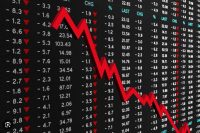
24th April 2025
It is sometimes worth reminding ourselves that it is this very uncertainty of shorter-term market outcomes that delivers investors with returns above those of holding funds on bank deposits and above inflation over longer periods of time. If there was no uncertainty, then there would be no additional return for holding riskier investments. It is impossible to predict what will happen next, either from President Trump or the reaction from countries around the world in response to the tariffs. We have recently seen that stock market movements can be swift and large in either direction and trying to second-guess what comes next could lead to adverse consequences for your wealth. You only have to look at the reversal of President Trump’s very public comments about the Head of the Federal Reserve this week, calling for his sacking, until he saw the reaction of markets and the sharply falling dollar.
The annual returns of markets are unpredictable and can vary significantly from year to year. Stock market falls are a feature of investing, not a sign that things are broken. The chart below shows the distribution of stock market returns for each calendar year since 1927. On the left-hand side is the annual return, ranging from a fall between 40% and 50% to rises of 50% to 60%. The chart then lists each year that has achieved this return. This visual representation highlights the range of outcomes that can occur, from exceptionally good years to notably bad ones.
Annual stock market returns in context
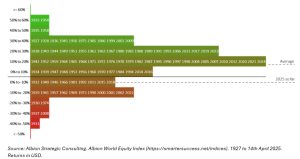
2023 and 2024 were both positive. Whilst 2025 so far sits on the wrong side of the zero line, it remains uncertain where stock markets will end up by the end of the year. The randomness of annual stock market returns serves as a reminder that short-term predictions are inherently unreliable. Sound investing requires focusing on the things you can control (risk management, broad diversification, investing costs, avoiding emotional reactions) and accepting those you cannot. For most investors, the spread of outcomes can be expected to be much narrower than that presented in the annual returns graphic above by using such techniques. Being diversified, diligent and patient in investing lends well to better outcomes.
Part of our role is to ensure that you are invested in the solution that provides you with the best chance of achieving your financial goals whilst keeping risk at a level you are comfortable with. Our Investment Committee is responsible for the regular and comprehensive oversight of your Old Mill investment solution and implementation of the investment strategy underpinning your financial plan. To protect portfolio values from market volatility, such as that we are currently witnessing, our investment strategy incorporates a number of protection mechanisms to reduce the impact of these market swings:
1. Owning bonds: High quality bonds can act as a buffer against heightened stock market uncertainty. They tend to perform well when equities are underperforming, as investors flee in search of ‘safer’ havens. Your defensive assets have remained flat through the sharp falls of growth assets.
2. Diversification: Spreading investments across a wide range of companies, sectors, and geographical regions can reduce the risk associated with any single investment. This leads to your portfolio with over 13,000 individual companies and a spread of assets for a medium risk portfolio as shown below:
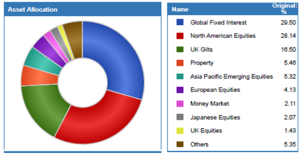
3. Regular portfolio rebalancing: Periodically reviewing and, if necessary, adjusting the portfolio to maintain the desired asset allocation can help manage risk. Rebalancing ensures that the portfolio remains aligned with the investor’s long-term goals and risk objectives.
Performance over the last year (up to Wednesday 23 April)
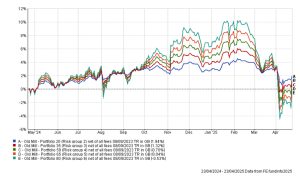
Performance of our Values portfolios over the last year (up to Wednesday 23 April)
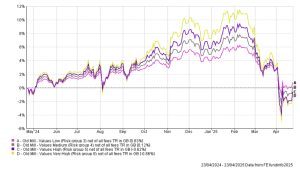
Here are some quick tips to remember when markets fall. With the endless speculation in the media, we know recent events can be troubling, but please be assured that our investment process is built to deal with situations like these.
✅The news isn’t designed to reassure you. At times like these, articles will be full of the worst set of circumstances that could happen.
✅ Don’t look at your portfolio too often. At a review meeting with your financial planner, any fall or rise can be explained in the context of your own circumstances.
✅The balance between your growth (equity) assets and defensive (high quality bond) assets was established by your adviser to make sure that you can withstand temporary falls in the value of your portfolio, both emotionally and financially. Be confident that your (boring) defensive assets will come into their own, protecting your portfolio from some of the equity market falls.
✅ Accept that you cannot time when to be in and out of markets – it is simply not possible. Hindsight prophecies – ‘I knew the market was going to crash’ – are not helpful.
✅ Your financial planner is there – at any time – to talk to you. He or she can act as your coach to encourage and reassure you to stay the course. They are a source of fortitude, patience and discipline.
If you need financial advice on wealth management or investment management, contact us today to speak to our financial planners.
